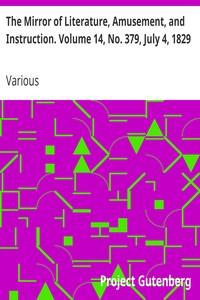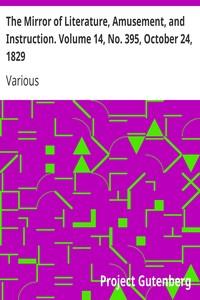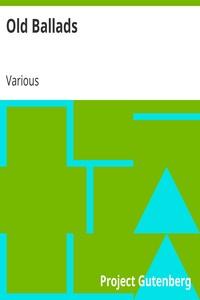|
|
Read this ebook for free! No credit card needed, absolutely nothing to pay.Words: 17842 in 6 pages
This is an ebook sharing website. You can read the uploaded ebooks for free here. No credit cards needed, nothing to pay. If you want to own a digital copy of the ebook, or want to read offline with your favorite ebook-reader, then you can choose to buy and download the ebook.

: The Mirror of Literature Amusement and Instruction. Volume 14 No. 379 July 4 1829 by Various - Popular literature Great Britain Periodicals The Mirror of Literature Amusement and Instruction@FreeBooksTue 06 Jun, 2023 THE MIRROR OF LITERATURE, AMUSEMENT, AND INSTRUCTION. MILAN CATHEDRAL; situate almost in the centre, and occupying part of the great square of the city. It is of Gothic architecture, and its materials are white marble. In magnitude this edifice yields to few in the universe. Inferior only to the Vatican, it equals in length, and in breadth surpasses, the cathedral of Florence and St. Paul's; in the interior elevation it yields to both; in exterior it exceeds both; in fretwork, carving, and statues, it goes beyond all churches in the world, St. Peter's itself not excepted. Its double aisles, its clustered pillars, its lofty arches; the lustre of its walls; its numberless niches all filled with marble figures, give it an appearance novel even in Italy, and singularly majestic. The admirer of English Gothic will observe one peculiarity, which is, that in the cathedral of Milan there is no screen, and that the chancel is entirely open, and separated from the nave only by its elevation. The pillars of the cathedral of Milan are more than ninety feet in height, and about eight in diameter. The dimensions of the church at large are as follow:--In length four hundred and ninety feet, in breadth two hundred and ninety-eight, in interior elevation under the dome two hundred and fifty-eight, and four hundred in exterior, that is to the summit of the tower. The pavement is formed of marble of different colours, disposed in various patterns and figures. The number of niches is great, and every niche has its statue, which, with those placed on the ballustrade of the roof, are reported to amount to more than four thousand. Many among them are said to be of great merit. Over the dome rises a tower or spire, or rather obelisk, for its singular shape renders it difficult to ascertain its appellation, which, whatever may be its intrinsic merit, adds little either to the beauty or to the magnificence of the structure which it surmounts. This obelisk was erected about the middle of the last century, contrary to the opinion of the best architects. Though misplaced, its form is not in itself inelegant, while its architecture and mechanism are extremely ingenious, and deserve minute examination. In ascending the traveller will observe, that the roof of the church is covered with blocks of marble, connected together by a cement, that has not only its hardness and durability, but its colour, so that the eye scarcely perceives the juncture, and the whole roof appears one immense piece of white shining marble. The view from the summit is extensive and even novel, as it includes not only the city and the rich plain of Milan, intersected with rivers and canals, covered with gardens, orchards, vineyards, and groves, and thickly studded with villages and towns; but it extends to the grand frame of this picture, and takes in the neighbouring Alps, forming a magnificent semicircle and uniting their bleak ridges with the milder and more distant Apennines. The traveller, says Eustace, will regret as he descends, that instead of heaping this useless and cumbersome quarry upon the dome, the trustees of the edifice did not employ the money expended upon it in erecting a front, corresponding with the style and stateliness of this superb temple. A front has indeed been begun, but in a taste so dissimilar to that of the main building, and made up of such a medley of Roman orders and Gothic decorations, that the total suspension of such a work might be considered as an advantage, if a more appropriate portal were to be erected in its place. But unfortunately the funds destined for the completion and repair of this cathedral are now swallowed up in the general confiscation. Had it been finished, and the western front built in a style corresponding with the other parts, the admirers of the Gothic style would have possessed one specimen perfect in its kind, and accompanied with all the advantages of the best materials, set off by a fine climate. In materials, the cathedral of Milan surpasses all the churches of the universe, the noblest of which are only lined and coated with marble, while this is entirely built, paved, vaulted, and roofed with the same substance, and that of the whitest and most resplendent kind. The most remarkable object in the interior of this church is the subterranean chapel, in which the body of St. Charles Borromeo reposes. It is immediately under the dome, in form octangular, and lined with silver, divided into panels representing the different actions of the life of the saint. The body is in a shrine of rock crystal, on, or rather behind the altar; it is stretched at full length, drest in pontifical robes, with the crosier and mitre. The face is exposed, very improperly, because much disfigured by decay, a deformity increased and rendered more hideous by its contrast with the splendour of the vestments which cover the body, and by the pale ghastly light that gleams from the aperture above. The inscription over this chapel or mausoleum, was dictated by St. Charles himself, and breathes that modesty and piety which so peculiarly marked his character. It is as follows: CAROLUS CARDINALIS TITULI S. PRAXEDIS ARCHIEP. MEDIOLAN. FREQUENTIORIBUS CLERI POPULIQ. AC DEVOTI FAEMINEI SEXUS PRECIBUS SE COMMENDATUM CUPIENS HOC LOCO SIBI MONUMENTUM VIVENS ELEGIT. The following lines are inscribed on its pedestal, in Latin, and in English:-- Lest at the sculptor doubtfully you guess, 'Tis Marc Agrati, not Praxiteles. This statue is reckoned worth its weight in gold. In describing this magnificent cathedral, we have availed ourselves of abridging the description in Eustace's "Classical Tour," a work of high authority and sterling value on all subjects connected with the Fine Arts. RUSTIC AMUSEMENTS. Free books android app tbrJar TBR JAR Read Free books online gutenberg More posts by @FreeBooks
: The Mirror of Literature Amusement and Instruction. Volume 14 No. 395 October 24 1829 by Various - Popular literature Great Britain Periodicals The Mirror of Literature Amusement and Instruction@FreeBooksTue 06 Jun, 2023

: The Bent Twig by Fisher Dorothy Canfield - Young women Fiction; Domestic fiction; Bildungsromans; Middle West Fiction@FreeBooksTue 06 Jun, 2023
|
Terms of Use Stock Market News! © gutenberg.org.in2025 All Rights reserved.






